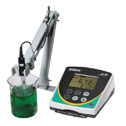pH Meters and Water Quality Products

What is pH?
pH is a measure of a liquid's acidity or alkalinity as given by the relative quantity of hydrogen ions (H+) it contains. The greater the concentration of H+ ions, the more acidic the solution and the lower the pH. Conversely, the lower the H+ concentration, the more basic (or alkaline) the solution and the higher the pH. pH is formally defined as the negative log of H+ activity. This means that every pH unit expresses a tenfold change in acidic strength.
Why is pH important?
pH measurement is critical to a wide variety of industries that affect our everyday lives. Industries such as water and wastewater treatment, chemical production, agriculture, environmental monitoring, life science research, pharmaceutical production, and electronics manufacturing all rely heavily on accurate pH measurement for their processes. Consequently, pH is now the most widely tested chemical parameter in the world.
How do I measure pH?
Quick and dirty pH measurement can be achieved through litmus paper or pH indicators. These are convenient because of their low cost and ease of use, but they can only provide a rough indication of pH, which is insufficient for most applications. The more accurate method involves the use of a measurement system consisting of a pH meter, an electrode that is sensitive to H+ions, and calibration buffer solutions. The effect that H+ ions have on the electrode can be measured and converted to a pH value by the meter.
Meter Selection
@esgdm has pH meters that are suitable for almost any purpose. Select your meter based on the requirements of your application. Pocket-sized testers are great for their low cost and small size. Handheld, portable meters typically offer more features than testers and are good for laboratory and field use. Benchtop meters are ideal for stationary lab applications typically offering larger displays and more robust data management than other types of meters. ISFET (ionspecific field effect transistor) meters are a unique subset of pH meter that utilize a silicon chip sensor in lieu of a traditional pH-sensitive glass bulb electrodes. This makes them perfect for applications where the presence of glass presents an issue such as with food production.
Electrodes
Most pH measurement systems feature standard pH electrodes with glass bulbs made from pH-sensitive glass, yet there is a wide variety of configurations to handle specialized applications.
Buffers
All pH meters require calibration standards to ensure that the readings are traceable to a standard. Always choose a pH 7 buffer plus at least one other pH value close to your expected measurement range. Using solutions of known pH value allow you to adjust the system to read accurate measurements. Calibration should be performed before each reading or each set of readings
.
Why is pH important?
pH measurement is critical to a wide variety of industries that affect our everyday lives. Industries such as water and wastewater treatment, chemical production, agriculture, environmental monitoring, life science research, pharmaceutical production, and electronics manufacturing all rely heavily on accurate pH measurement for their processes. Consequently, pH is now the most widely tested chemical parameter in the world.
How do I measure pH?
Quick and dirty pH measurement can be achieved through litmus paper or pH indicators. These are convenient because of their low cost and ease of use, but they can only provide a rough indication of pH, which is insufficient for most applications. The more accurate method involves the use of a measurement system consisting of a pH meter, an electrode that is sensitive to H+ions, and calibration buffer solutions. The effect that H+ ions have on the electrode can be measured and converted to a pH value by the meter.
Meter Selection
@esgdm has pH meters that are suitable for almost any purpose. Select your meter based on the requirements of your application. Pocket-sized testers are great for their low cost and small size. Handheld, portable meters typically offer more features than testers and are good for laboratory and field use. Benchtop meters are ideal for stationary lab applications typically offering larger displays and more robust data management than other types of meters. ISFET (ionspecific field effect transistor) meters are a unique subset of pH meter that utilize a silicon chip sensor in lieu of a traditional pH-sensitive glass bulb electrodes. This makes them perfect for applications where the presence of glass presents an issue such as with food production.
Electrodes
Most pH measurement systems feature standard pH electrodes with glass bulbs made from pH-sensitive glass, yet there is a wide variety of configurations to handle specialized applications.
Buffers
All pH meters require calibration standards to ensure that the readings are traceable to a standard. Always choose a pH 7 buffer plus at least one other pH value close to your expected measurement range. Using solutions of known pH value allow you to adjust the system to read accurate measurements. Calibration should be performed before each reading or each set of readings
.
Comentarios
Publicar un comentario